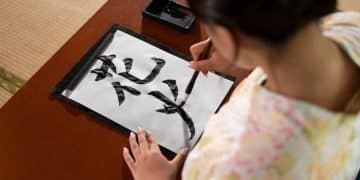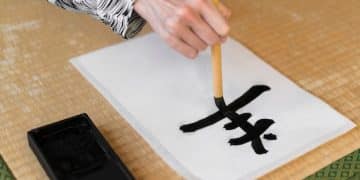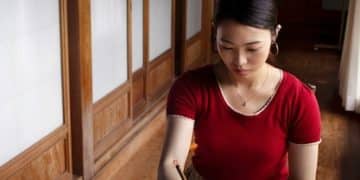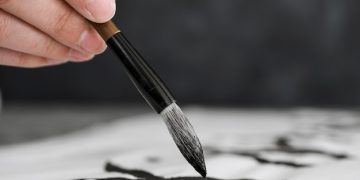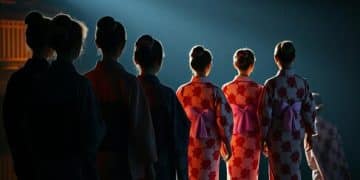Korean Calligraphy: Techniques & Styles for US Enthusiasts
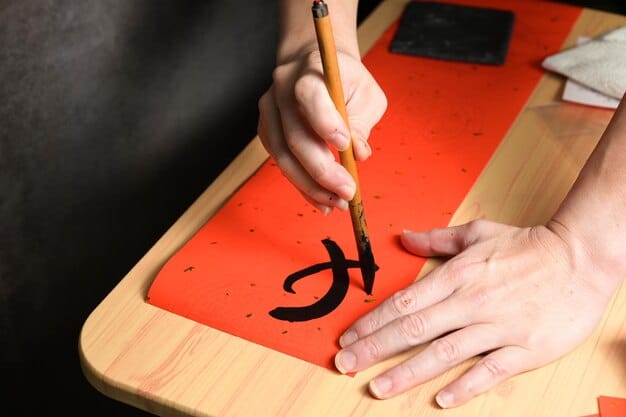
Exploring the world of Korean calligraphy unveils its rich history, diverse techniques, and elegant styles, offering US enthusiasts a unique path to artistic expression and cultural appreciation.
Have you ever been captivated by the elegant brushstrokes gracing the backgrounds of K-dramas? That’s often Korean calligraphy, or *Seoye*, a beautiful art form with a rich history. This article serves as your guide to Korean calligraphy: Techniques and Styles for US Enthusiasts, offering a glimpse into its captivating world.
Understanding Korean Calligraphy: An Introduction
Korean calligraphy, known as *Seoye* (서예), is more than just writing; it’s an art form that embodies the philosophical and cultural heritage of Korea. It reflects the calligrapher’s spirit and personality through the ink, brush, and paper.
For American enthusiasts eager to explore this ancient art, understanding its roots and appreciating its nuances is the first step on a rewarding artistic journey.
The History and Significance of Seoye
Seoye’s history is deeply intertwined with the adoption of Chinese characters (Hanja) in Korea. Over time, Korean calligraphers developed their unique styles, influenced by Confucianism, Buddhism, and Taoism. It was considered one of the four essential arts for scholars, alongside painting, poetry, and music.
The strokes hold immense cultural significance, with each character representing not just a word, but also embodying the calligrapher’s inner state and understanding of the world.
Key Components of Korean Calligraphy
Mastering Seoye involves understanding its essential components:
- Brush (붓 – *but*): The choice of brush affects the ink flow and stroke quality.
- Ink (먹 – *meok*): Ink is made by grinding an inkstick with water on an inkstone.
- Paper (종이 – *Jongi*): Traditional Hanji paper is preferred for its absorbency and texture.
- Inkstone (벼루 – *byeoru*): Used for grinding the inkstick and mixing ink.
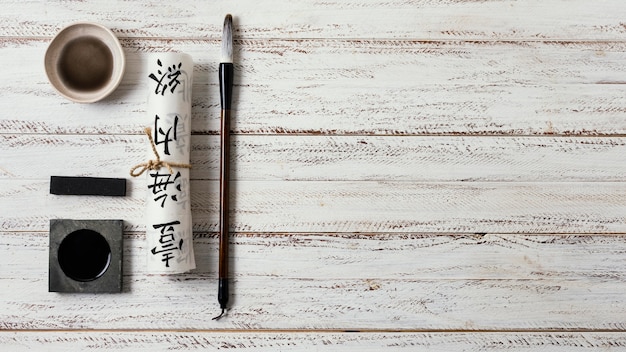
These elements harmonize to bring the calligrapher’s vision to life, creating works that are both visually stunning and deeply meaningful.
In conclusion, understanding the historical context and essential components of *Seoye* is crucial for any US enthusiast aiming to delve into the world of Korean calligraphy. By appreciating its rich heritage and mastering its techniques, one can embark on a fulfilling artistic journey.
Exploring the Different Styles of Korean Calligraphy
Korean calligraphy boasts a rich tapestry of styles, each with its unique characteristics and historical influences. Understanding these styles equips US enthusiasts with a deeper appreciation for the art form.
From the formal to the expressive, each style offers a different path for artistic exploration and self-expression.
The Five Major Styles (Obche)
The five major styles, known as *Obche* (오체), form the foundation of Korean calligraphy:
- Seal Script (篆書 – Jeonseo): Ancient and formal, often used for seals and inscriptions.
- Clerical Script (隸書 – Yeseo): More simplified than Seal Script, developed for administrative use.
- Regular Script (楷書 – Haeseo): Precise and structured, considered the standard style for learning.
- Running Script (行書 – Haengseo): Semi-cursive, allowing for greater fluidity and expression.
- Cursive Script (草書 – Choseo): Highly stylized and abbreviated, emphasizing speed and artistic freedom.
Each style requires dedicated practice to master its nuances and unique brush techniques. Begin with Haeseo to build a solid foundation before exploring the more fluid styles.
Regional Variations and Modern Interpretations
Beyond the *Obche*, regional variations and modern interpretations add further depth to Korean calligraphy. For example:
- Gungche: A uniquely Korean style developed during the Joseon Dynasty, known for its elegance and refinement.
- Sajeokpilgam: “Writing with the strength of historical figures”, embodies the spirit of great calligraphers of the past.
Modern calligraphers continue to push boundaries, blending traditional techniques with contemporary aesthetics to create innovative and captivating works of art.
Understanding the diverse styles is vital for US enthusiasts as it allows for a wider exploration of artistic expression within Korean calligraphy. Each style embodies a unique character, offering a distinct path for personal artistic development.
Essential Tools and Materials for Beginners
Embarking on the journey of Korean calligraphy requires acquiring the right tools and understanding their importance. Selecting high-quality materials ensures a smoother learning process and helps achieve the desired artistic results.
For American beginners, knowing where to source these tools and how to care for them is crucial for sustained progress and enjoyment.
Selecting the Right Brush (But)
The brush is the calligrapher’s most important tool. Considerations when choosing a brush:
- Hair Type: Goat, sheep, and wolf hair are common, each offering different levels of stiffness and absorbency.
- Size and Shape: Different sizes are suited to various script styles; experiment to find what feels most comfortable.
Caring for your brush involves washing it immediately after use and storing it properly to maintain its shape and longevity. This ensures it remains a reliable tool for practice.
Understanding Ink (Meok) and Inkstone (Byeoru)
Traditional ink is created by grinding an inkstick on an inkstone. The quality of both items impacts the ink’s consistency and color.
Choose an inkstone with a smooth, even surface and an inkstick that produces a rich, dark ink. Experiment with different grinding techniques to achieve the desired consistency.
Choosing Paper (Hanji)
Hanji, traditional Korean paper, is ideal for calligraphy due to its absorbency and texture. It allows the ink to spread beautifully, creating unique visual effects.
Different types of Hanji exist, so experiment to find the ones that best suit your preferred styles and techniques. Sourcing Hanji in the US might require online retailers or specialty art stores.
For US beginners, investing in quality tools and materials is an essential step toward mastering Korean calligraphy. Understanding their properties and proper care ensures a fulfilling artistic journey and brings out the best in your work.
Techniques and Practice Exercises for US Learners
Mastering Korean calligraphy requires dedicated practice and understanding of basic techniques. Implementing effective exercises can accelerate learning and build a solid foundation.
For US learners, adapting traditional methods to suit a modern learning environment is key to achieving proficiency and artistic satisfaction.
Basic Strokes and Their Meanings
Korean calligraphy emphasizes eight basic strokes that form the foundation for all characters:
- Dot (점 – Jeom): Represents a seed or beginning.
- Horizontal Line (횡 – Hoeng): Symbolizes levelness and stability.
- Vertical Line (수직 – Sujik): Represents uprightness and strength.
- Left-Falling Stroke (삐침 – Ppichim): Imparts elegance and grace.
Practicing these strokes repeatedly helps develop muscle memory and control, improving overall brush technique. Understanding their symbolism adds depth to the learning experience.

Practice Exercises for Beginners
Start with simple exercises to build fundamental skills:
- Tracing: Trace characters from a textbook or exemplar to familiarize yourself with their structure.
- Copying: Copy characters alongside an exemplar, paying attention to stroke order and composition.
Consistent practice is key to improvement. Dedicate regular time to these exercises to develop fluency and confidence. Don’t be afraid to experiment and find your own style within the traditional framework.
Adopting proven techniques and engaging in targeted practice exercises is vital for US learners of Korean calligraphy. By focusing on building a strong foundation, you can unlock your artistic potential and express yourself beautifully through this ancient art form.
Finding Inspiration and Resources in the US
For US enthusiasts, connecting with Korean calligraphy can sometimes feel challenging due to geographical distance. However, numerous resources and avenues for inspiration are available to foster a vibrant community and support learning.
From online platforms to local workshops, various opportunities exist to engage with *Seoye* and connect with fellow enthusiasts.
Online Communities and Learning Platforms
The internet offers a wealth of resources for learning Korean calligraphy:
- Online Courses: Platforms like Coursera and Udemy offer courses in Korean calligraphy, taught by experienced instructors.
- Virtual Workshops: Participate in online workshops that provide real-time instruction and feedback.
Engaging with online communities can provide valuable support, feedback, and inspiration as you progress on your calligraphy journey.
Local Workshops and Cultural Centers
Explore local opportunities to connect with the art form:
- Korean Cultural Centers: Check for calligraphy classes or workshops at Korean cultural centers in major US cities.
- Art Museums: Visit museums with Korean art collections to see examples of traditional calligraphy firsthand.
Connecting with other enthusiasts and learning from experienced practitioners can enrich your understanding and appreciation of Korean calligraphy. Look for meet-up groups or local art organizations offering related activities.
Finding inspiration and resources within the US is entirely feasible for aspiring Korean calligraphers. By utilizing online platforms, exploring local opportunities, and connecting with fellow enthusiasts, you can nurture your passion and develop your skills effectively.
Preserving and Displaying Your Calligraphy Art
After dedicating time and effort to creating beautiful calligraphy pieces, it is essential to know how to preserve and display them properly. Appropriate care ensures that your artwork remains visually stunning and culturally significant for years to come.
Understanding the best practices for framing, storing, and showcasing your *Seoye* is a final step in honoring this ancient art form.
Framing and Mounting
Framing your calligraphy protects it from dust, moisture, and sunlight. Consider these points:
- Acid-Free Materials: Use mats and backing boards that are acid-free to prevent discoloration over time.
- UV-Protective Glass: Opt for UV-protective glass to shield the ink from fading.
Alternatively, consider traditional mounting techniques such as backing the calligraphy onto a scroll to make it easier to store, roll and display.
Storage Tips
Proper storage also plays a crucial role in preserving your artwork:
- Avoid Direct Sunlight: Store your calligraphic works away from direct sunlight to prevent fading of the ink.
- Control Humidity: Avoid areas with high humidity, which can damage the paper and ink.
Store your calligraphy in a cool, dry place, ideally in protective sleeves or folders to protect them from physical damage.
Equally important is learning the right methods to frame, showcase and store your Korean calligraphy pieces effectively. By following these tips, you not only celebrate your artistic achievements but also contribute to the preservation of this beautiful art form.
| Key Point | Brief Description |
|---|---|
| 📜 History of Seoye | Traces back to Chinese characters, evolving with Korean culture and thought. |
| 🖌️ Essential Tools | Includes brush, ink, paper (Hanji), and inkstone, each with specific qualities. |
| ✍️ Practice Techniques | Focus on mastering basic strokes and practicing with tracing and copying. |
| 🖼️ Preserving Art | Involves proper framing, storage, and handling to protect from damage and fading. |
What are the key differences between Korean and Chinese calligraphy?
While both share roots, Korean calligraphy, or *Seoye*, has evolved distinctly with its own styles influenced by Korean culture and philosophy. The brushstrokes and character designs exhibit unique nuances.
How can I find authentic Hanji paper in the United States?
▼
Specialty art supply stores and online retailers are good places to start. Look for paper specifically labeled as Hanji and ensure it is made from traditional Korean mulberry fibers for authenticity.
What is the best way to clean and care for my calligraphy brushes?
▼
Rinse your brush thoroughly with cool water after each use to remove all ink. Gently reshape the bristles and allow the brush to air dry completely before storing it horizontally or hanging it upside down.
Are there any famous Korean calligraphers I should study for inspiration?
▼
Yes, explore works by Kim Jeong-hui, known as Chusa. His unique abstract style is a masterclass in calligraphic expression. Also, check out Kang Hee-an’s style, which is very famous.
